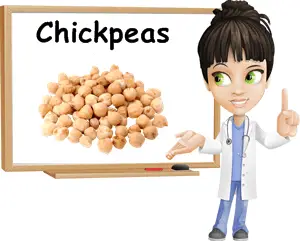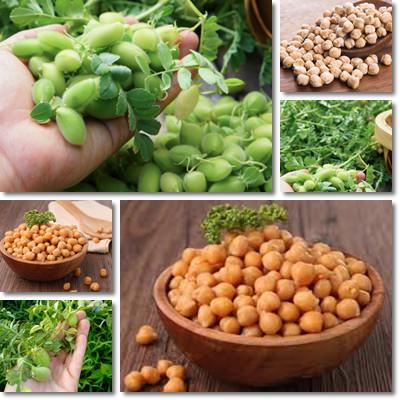Appetizing, creamy and deliciously nutty in flavor, chickpeas (Cicer arietinum) are a great source of protein as well as dietary fiber. Chickpeas are rich in iron, zinc, phosphorus and vitamins B9 and B6 and supply the body with a variety of essential nutrients such as tryptophan, lysine and isoleucine.
Regular consumption of the legume helps regulate gastrointestinal transit and, due to the high fiber intake, efficiently relieves constipation.
Chickpeas represent a good substitute for meat due to their high protein content and contribute to strengthening and reinvigorating the body as a result of their considerable iron content. They are beneficial for muscle health and the cardiovascular system and play an important part in supporting nervous system activity. For example, the good amounts of the amino acid tryptophan helps regulate appetite, sleep and mood, improving various aspects of brain health.

What do chickpeas look like?
Chickpeas are small, creamy-white, green or black, round, hard seeds. They are found inside small, elongated green pods, with each pod housing anywhere from one to three peas. They are available for purchase as uncooked, dried seeds or cooked, typically canned.
What do chickpeas taste like?
Chickpeas have a delicious nutty flavor and a pleasant crunch and brittleness to them. They are great roasted, mashed for a creamy soup or paired with rice or meat. They are quite a versatile legume with a great texture and a wonderful, mild nutty taste. Chickpeas fall into the category of legumes, in the Leguminosae family.
Other common names for chickpeas include ceci or cece, gram, Egyptian beans and garbanzo beans. They are available all year round and can be found either fresh, or canned, even dried. Chickpeas come in several colors: green, black, cream and white. They go well in salads, stews, curry, as a main course or side dish. Having a creamy texture and a nutty flavor, it should be easy to convince even your children to eat them, especially finely mashed and spread on bread.

What are the benefits of Chickpeas?
Chickpeas are healthy and good for you. See below what are top 10 benefits of eating chickpeas:
Good for high cholesterol
Regular consumption is said to help lower LDL (bad) cholesterol levels, as well as total cholesterol levels. Low cholesterol means healthier arteries and lower risks of cholesterol plaques building up on the inside of artery walls, restricting normal blood flow.
Anticancer properties
Chickpeas contain powerful phytochemicals called saponins, which boast great antioxidant activity. Recent studies suggest that the saponins in chickpeas reduce the risk of breast cancer as well as osteoporosis via a strong antioxidant activity.
Great source of molybdenum
Being rich in molybdenum (80% of the RDI, recommended daily intake), chickpeas provide antioxidant protection and help prevent tooth decay, growth retardation as well as delay aging. Moreover, molybdenum helps the body get rid of sulfites by initiating a natural detoxification process.
Great source of manganese
Chickpeas supply the body with an astounding 273% of the RDI of manganese, a potent antioxidant mineral. Regular consumption promotes cell repair, protects against free radical damage to DNA structures and chronic diseases. Also, their good manganese content contributes to energy metabolism and elevated energy levels.
High protein food
Chickpeas are recommended for people leading a vegetarian or vegan lifestyle due to their high protein content: 8.86 g of protein/100 g of cooked peas. The protein in the legume provides us with good amounts of an amino acid called tryptophan, which regulates appetite, sleep and mood, contributing to better sleep, improved appetite, reduced hunger and cravings as well as better overall mood.
High fiber food
High in fiber (7.6 g), chickpeas are an excellent natural remedy against constipation. Also, regular consumption of fiber-rich legumes such as beans, peas, chickpeas, nuts and seeds helps regulate transit time, promote colon health and improve hemorrhoids symptoms.
See what foods to eat and to avoid for hemorrhoids.
Dietary fiber also partially prevents the absorption of cholesterol and fats from food at the intestinal level, indirectly contributing to lower cholesterol levels and improved cardiovascular health. Legumes, nuts and seeds in general provide an excellent fatty acid content as well a generous dietary fiber intake.
At the same time, eating too many chickpeas at once or eating chickpeas too frequently can up fiber intake to the point of digestive upset. Side effects of excess chickpeas consumption include stomach pain, abdominal cramps, bloating, gas and loose stools and diarrhea.
Blood sugar-lowering properties
Due to their high fiber intake, chickpeas make an ideal food for people suffering from diabetes or pre-diabetes conditions such as high blood sugar levels because they regulate glucose and insulin levels, preventing fluctuations that could affect energy metabolism and cause fatigue.
Benefits for anemia, muscle weakness and fatigue
Chickpeas are a good source of iron (25% of the RDI) and are thus recommended for anemia-sufferers as well as women of fertile age. Iron is vital for the production of red blood cells which transport oxygen from the lungs to muscles, preventing muscle weakness and fatigue associated with anemia. Moreover, the mineral is a prerequisite for good fertility.
Good source of B vitamins
With a good B vitamin content, chickpeas support carbohydrate synthesis. 100 g of cooked chickpeas provide about 50% of the RDI of folic acid, or vitamin B9. Since it is crucial for the health of newborns, reducing risks of neural tube defects of the brain, spine and spinal cord, expecting mothers should have a generous intake of folic acid.
Good source of magnesium, phosphorus and zinc
Last but not least, chickpeas provide good amounts of essential minerals such as magnesium, phosphorus and zinc. Regular consumption is thus beneficial for the good functioning of the heart and other muscles in the body, with a reduced incidence of muscle cramps and twitching, promotes hormonal balance, digestive and bone health and strengthens the immune system.
